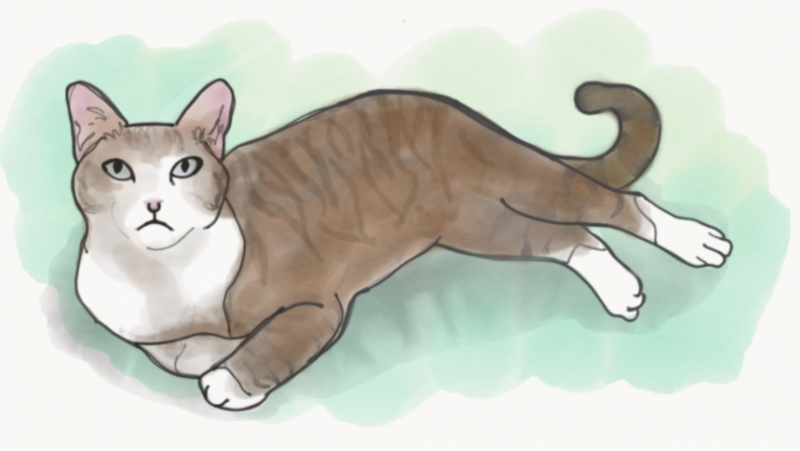Which new cats can stay on campus, and which ones have to go? Mindy Morales, Trinity’s computer aided drafting technician and director of the Cat Alliance, said that the answer is as much up to Trinity’s cats as its humans. To be a campus cat, one must first be accepted by a local colony.
“Sometimes, the cats like the newcomer, and they say come on in,” Morales said. “They’re just like humans: they like some people and they don’t like others.”
Over the past two months, a total of seven new cats were found on Trinity’s campus, marking an anomalous increase from the usual one to two homeless cats the Cat Alliance processes each year. The cats were primarily discovered by Trinity residential life staff over the winter break.
Of the seven, two cats ran away or disappeared after being discovered, two were adopted into new families and one, discovered Friday of last week, remains to be placed in a permanent home. Two new cats — Biggie and Hamlet — remain at Trinity as permanent campus residents.
“If a cat stays around for a period of time, and it looks like it’s settling in, then we’re okay that it lives here, if it’s not creating any problems,” Morales said.
Prior to the formation of the Trinity Cat Alliance about 15 years ago, more than 60 stray cats called Trinity’s campus home. Now, 23 cats roam campus, all of whom are spayed or neutered, vaccinated for various diseases and fed regularly by Cat Alliance members, in the hopes that these measures will both reduce any aggressive tendencies and keep the cat population small.
The Alliance follows the Trap Neuter Return (TNR) program, which returns stray cats to the environment rather than euthanizing them. Morales sees this as a reasonable if imperfect solution to San Antonio’s homeless animal issue.
“In the perfect world, we would have no cats on campus because all cats would have a home,” Morales said. “But that is not the case, particularly in San Antonio, which has … many homeless animals, and many are euthanized every year. So TNR is plan B.”
Each new campus cat is taken to the vet.
“We … make sure [the cat is] healthy, it doesn’t have any diseases, make sure it has vaccinations,” Morales said. “An eartip [indicates] that this is a cat we’ve sent through the process, and then we bring it back and release it.”
There is a reason, however, that most homeless cats do not stay on campus permanently — a reason beyond not fitting in socially. Many abandoned cats are too domesticated to ever have a life outdoors.
One such cat was discovered outside of a dorm in mid-December by director of Residential Life Deborah Tyson. This cat was almost certainly dumped outside by a Trinity student, according to Tyson.
“He showed up immediately as the students were moving out,” Tyson said. “I identified him right in those past couple of days, that he was desperately trying to get back into McLean.”
Tyson called the cat Witt because he was brought into the Witt Reception Center for protection. Witt was clearly used to living indoors and seemed heartbroken after his abandonment.
“Anyone who met Witt was just astounded,” Tyson said. “He just cried and cried and cried. In fact, he cried all the way from McLean, followed me up the sidewalk, cried outside of the Witt Center and cried all the way in the Witt Center. And for the first two days, he did nothing but cry.”
Witt eventually found a permanent home with a Trinity alum, but this came after six weeks of living in the Witt Center.
According to Morales, the process of finding a home for an abandoned cat can be extensive. First, the Cat Alliance will send an email to a listserv called TigerTalk, which includes certain faculty and staff who opt in, with a picture and information about the homeless cat.
“We rely on people on TigerTalk to send it out further,” Morales said. “If I have to send out a second email because I haven’t had enough interest in the cat, then I will send it to the Cat Alliance listserv.”
This second email includes student members of Trinity’s Cat Alliance, which Morales admits is somewhat problematic. When it comes to candidates for pet adoption, students are a last resort.
“The biggest problem is, when [students] graduate, they don’t know what they’re going to do,” Morales said. “Their lives could take them anywhere and many times, it’s to somewhere where they can’t have a pet. It’s a little too soon in your life when you graduate from college, to adopt an animal, because you want the freedom to take a job in Chicago, or New York or wherever.”
For these reasons and others, individuals may sometimes be tempted to dump their unwanted animals outside. Tyson encourages those in tough situations to seek out advice rather than abandoning a pet.
“I would encourage any student who has an animal, whether approved or unapproved, to not take such a cruel action and release a domesticated animal to the outside,” Tyson said. “[The animals] don’t understand, they are terribly frightened, they’re confused and sorrowful. … They were the center of someone’s life and then now they’re gone, and so it breaks our hearts for them.”
Katherine Pyles, senior and member of the Cat Alliance, has volunteered at shelters before. She recommends that students seek out other homes for their unwanted animals before putting them in shelters because shelters are so often overcrowded.
“So first thing is, check if anyone in your community, in your immediate friend group, wants [the animal],” Pyles said. “The next is going to a foster situation. If you’re giving up an animal that is not in good health, you don’t want to immediately introduce that to a shelter and expect them to shoulder all the bills for that.”
However, Pyles believes that giving an animal to a shelter is much better than abandoning it.
“Definitely don’t drop them off, even if you don’t care what happens to the animal. Give it to a shelter and the shelter can make the decision to euthanize it or to keep it,” Pyles said.
Students with questions or concerns about campus cats can contact Mindy Morales at mbrent@trinity.edu.







